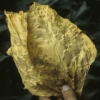General information of curing barn diseases
Above all, do not believe that when the tobacco is harvested, the leaves are out of danger; the tobacco leaf stays a potential substrate for micro-organisms. Indeed many lesions may occur during their curing and storage and cause huge losses. The origins of these lesions may be related to the development of micro-organisms, the impact of agricultural mistakes made during cultivation or poor management of curing or storage of tobacco.
When harvested, the tobacco leaves are mostly mature but still more or less green. Once they start to yellow, they are much more vulnerable and form an ideal natural substrate for many micro-organisms, especially bacteria and fungi. Among them, some of the pathogens attacking the plants during cultivation are observed but there are also others which occur on the surface of different organs of tobacco and partly form its phylloflora. Note that tobacco leaves may be polluted or contaminated in the field, from the soil or during air-curing in contaminated barns, from workers during harvesting and sorting or in the warehouse during storage.
These micro-organisms and their parasitic pressure fluctuate over time, depending especially on climatic conditions and the sanitary environment of the leaves. Their activities on tobacco vary:
- some of them are involved in the normal fermentation of dark tobacco;
- others are opportunistic saprophytes which use the senescent leaves and high humidity to grow and cause rot and / or mould;
- as mentioned earlier, some tobacco pests show their pathogenicity already in the field. You can see how in Leaf abnormalities and lesions section. In this case, curing reveals the symptoms already more or less visible before harvest, or favours the late or latent infections in curing barns (figures 1 to 4).
 |
 |
 |
 |
 |
| Figure 1 | Figure 2 | Figure 3 | Figure 4 | Figure 5 |
Note that contaminations can occur through the petiole scars ("pole rot"), through various lamina injuries, especially those caused by leaf fixing devices. Moreover, they may occur also through stomata or directly through the cuticle. They are mostly favoured by the prevailing ambient humidity during curing and storage of tobacco. If the harvest and / or air-curing take place during a rainy period, the risk of damage is very high. Poor control of the Virginia tobacco yellowing phase, or tobacco storage in cold warehouses with poor ventilation leads to the same situation. Note that the hot air-curing does not destroy all micro-organisms present on the leaves.
Finally, these micro-organisms developing on the stem, leaf veins and inter-veinal tissues, alter the tissues that change colour and consistency compared to remaining healthy lamina parts. Their enzymes allow them to easily degrade cellulose and / or lignin and cause rot. In many cases, a mould can be observed on the surface of damaged tissues. Its colour will vary depending on the species involved (blue, green, black, grey, yellow, brown) (figure 5).





